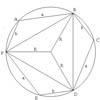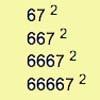Reasoning, convincing and proving
-
 problemA car is travelling along a dual carriageway at constant speed. Every 3 minutes a bus passes going in the opposite direction, while every 6 minutes a bus passes the car travelling in the same direction. Buses leave the depot at regular intervals; they travel along the dual carriageway and back to the depot at a constant speed. At what interval do the buses leave the depot?
problemA car is travelling along a dual carriageway at constant speed. Every 3 minutes a bus passes going in the opposite direction, while every 6 minutes a bus passes the car travelling in the same direction. Buses leave the depot at regular intervals; they travel along the dual carriageway and back to the depot at a constant speed. At what interval do the buses leave the depot? -
 problem
problemTetra perp
Show that the edges $AD$ and $BC$ of a tetrahedron $ABCD$ are mutually perpendicular if and only if $AB^2 +CD^2 = AC^2+BD^2$. This problem uses the scalar product of two vectors.
-
 problem
problemThree by one
There are many different methods to solve this geometrical problem - how many can you find?
-
 problem
problemHexy-metry
A hexagon, with sides alternately a and b units in length, is inscribed in a circle. How big is the radius of the circle?
-
 problem
problemOrdered sums
Let a(n) be the number of ways of expressing the integer n as an ordered sum of 1's and 2's. Let b(n) be the number of ways of expressing n as an ordered sum of integers greater than 1. (i) Calculate a(n) and b(n) for n<8. What do you notice about these sequences? (ii) Find a relation between a(p) and b(q). (iii) Prove your conjectures.
-
 problem
problemPythagoras for a tetrahedron
In a right-angled tetrahedron prove that the sum of the squares of the areas of the 3 faces in mutually perpendicular planes equals the square of the area of the sloping face. A generalisation of Pythagoras' Theorem.
-
 problem
problemRational round
Show that there are infinitely many rational points on the unit circle and no rational points on the circle x^2+y^2=3. -
 problem
problemLeonardo's problem
A, B & C own a half, a third and a sixth of a coin collection. Each grab some coins, return some, then share equally what they had put back, finishing with their own share. How rich are they? -
 problem
problemSixty-seven squared
Evaluate these powers of 67. What do you notice? Can you convince someone what the answer would be to (a million sixes followed by a 7) squared? -
 problem
problemEyes down
The symbol [ ] means 'the integer part of'. Can the numbers [2x]; 2[x]; [x + 1/2] + [x - 1/2] ever be equal? Can they ever take three different values?
